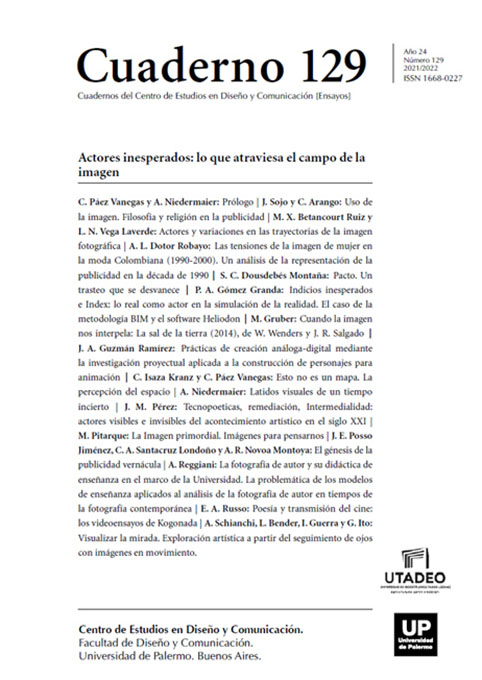Prácticas de creación análoga-digital mediante la investigación proyectual aplicada a la construcción de personajes para animación
Abstract
Through the consolidation of a workshop model that seeks to explore the creation processes that opt for both analog and digital forms of expression for three-dimensional animated production processes (referring to this aspect in both areas), a project research process is carried out that allows to consolidate the variables of conformation of characters that start from random variables, but that are being complemented by means of the investigation, the assimilation of existing models and the amalgamation of referents to arrive at the process of generating a matrix that allows the conceptual design of a character. From this input, a design begins not only of the structure in the formal sense of the character, but the construction of its movement, personality and mechanics, taking into account the limitations and possibilities that both analog and digital allow in development. and animation of said character. The process is iterative throughout the semester and seeks not only to feed a form of projective understanding of animated construction, but also seeks to question students about decision-making, the variables that affect the feasibility of a development that will be encouraged and the solutions they must face to solve in a practical way, which from the narrative is proposed in the first instance. As a result, an animated production of 5 seconds is reached, both in analogue and digital, where a practical application of the research is sought, as well as starting the process of understanding character design in the long term.
References
Barba, E. & Savarese, N. (2010). El arte secreto del actor: Diccionario de antropología teatral. (4th ed.). Lima: Editorial San Marcos E.I.R.L.
Bonsiepe, G.; Bürdek, B. E.; Fernández, S.; Hausmann, B.; Walther, E.; von Seckendorff, E.;… Huff, W. S. (2012). Modelos de Ulm, Modelos Post Ulm / hochschule für gestaltung Ulm 1953 - 1968. Retrieved from http://www.catedranaranja.com.ar/biblioteca/documentos/notas_apuntes/MODELOS_DE_ULM.pdf
Brigante, A. M. (2012). La Teoría de la Acción Poética de Paul Valéry. Pensamiento, 68(256), 273-286
Findeli, A.; Brouillet, D.; Martin, S.; Moineau, C. & Tarrago, R. (2008). Research Through Design and Transdisciplinarity: A Tentative Contribution to the Methodology of Design Research. «FOCUSED» - Current Design Research Projects and Methods, 67-91. Retrieved from http://swissdesignnetwork.ch/src/publication/focused-current-design-research-projects-and-methods-2008/SDN-Publication-2008_Focused.pdf#page=69
Giedion, S. (1970). Mechanization Takes Command - A Contribution to anonymous history (3rd ed.). New York: Oxford University Press.
Guzmán-Ramírez, J. A. (2019). Facultad de Artes y Diseño | Unidad Académica: Programas de Diseño Visual | Programa: Realización en Animación [Taller 2: Estructuras y Modelación]. Bogotá.
Guzmán Ramírez, A. (2018). Aportes a la Poética (Poietica) desde la Sociología de la Ciencia y el Constructivismo Social. In F. C. Londoño, A. Gómez Alzate, A. L. Grisales, & G. M. Mejía (Eds.), Diseño y Creación Foro Académico Internacional 17 festival Internacional de la Imagen. Nuevas expediciones. Universidad de Caldas.
Krippendorff, K. (2007). An Exploration of Artificiality. Artifact, 1(2), 17-22. https://doi.org/10.1080/17493460600610848 Latour, B. (2001). la esperanza de pandora - Ensayos sobre la realidad de los Estudios de la Ciencia (1st ed.). Barcelona: Editorial Gedisa.
Montoya Santamaría, J. W. (2011). Tecnociencia y racionalidad en el mundo contemporáneo. Trilogía - revista ciencia, tecnología y Sociedad, (4), 69-76.
Quintanilla, M. Á. (2000). Técnica y cultura. Teorema, 17(3), 1-16. Retrieved from http://www.oei.es/salactsi/teorema03.pdf Sanín Santamaría, J. D. (2006). ESTÉTICAS DEL CONSUMO Configuraciones de la cultura material. Universidad Nacional de Colombia, Medellín.
Valéry, P. (1990). Teoría poética y estética. Retrieved from https://ia902709.us.archive.org/25/items/ValeryPaulTeoriaPoeticaYEsteticaOCR/Valery-Paul-Teoria-poetica-y-estetica-OCR.pdf
Wagensberg, J. (1999). Complejidad e incertidumbre. Nuevas ideas para la inteligibilidad de las formas vivas. Mundo Científico, (201), 41-60.
Los autores/as que publiquen en esta revista ceden los derechos de autor y de publicación a "Cuadernos del Centro de Estudios de Diseño y Comunicación", Aceptando el registro de su trabajo bajo una licencia de atribución de Creative Commons, que permite a terceros utilizar lo publicado siempre que de el crédito pertinente a los autores y a esta revista.


